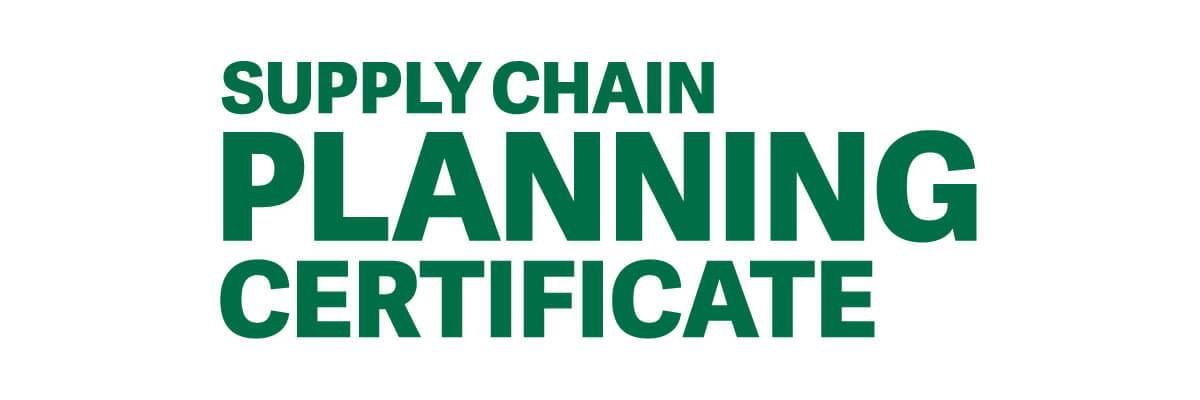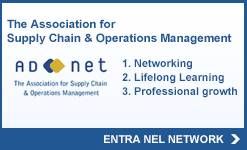Planning Certificate - APICS
E-Learning

DURATA
20 ore

PREZZO
Contattateci per conoscere il costo del corso e per iscrizioni.
Nella Supply Chain la sincronizzazione è fondamentale per avere produzione e consegne rapide e accurate. Coinvolgendo tutte le funzioni dell'azienda, è possibile allineare i processi di pianificazione e subire interruzioni nella Supply Chain significativamente inferiori.
Il programma Supply Chain Planning Certificate di ASCM introduce questi fondamenti di pianificazione essenziali e spiega chiaramente come integrare tutte le funzioni di pianificazione all'interno di un'azienda.
Il programma online e self-paced include 20 ore di formazione in inglese e un esame finale completo. Dopo aver superato l'esame, i partecipanti riceveranno il Supply Chain Planning Certificate di ASCM.
Su richiesta, è possibile abbinare il programma a delle sessioni Office Hours con i nostri istruttori certificati (tipicamente di 1,5 ore - ogni 2 settimane) per approfondimenti, spiegazioni e discussioni dei case studies.

Con questo programma il Team di Supply Chain apprenderà un linguaggio comune e una conoscenza condivisa sui seguenti aspetti:
- Gestione ottimale dell’intero processo di Manufacturing Planning & Control, dal Business Plan all’Execution
- Conoscenza e gestione ottimale del Master Production Schedule
- Conoscenza e gestione ottimale del MRP
- Gestione efficace dei meeting di pianificazione delle Operations/Supply. Gestione dell'Advance Planning & Scheduling
- Ruolo e ottimizzazione delle aree Logistics & Distribution
- Identificazione delle tecnologie per supportare una pianificazione sincrona
- Gestione efficace del controllo avanzamento della produzione
-
Piano didattico
LEGGI I DETTAGLI ▾
PROGRAMMA DETTAGLIATO
1. What Is Synchronized Planning?
Planning
Why Do Companies Plan?
How Do Companies Plan?
Manufacturing Planning and Control (MPC) System
MPC Overview
Strategic Planning
Operations Management Planning
Operations Execution
Distribution Planning
Technologies within Strategic Planning
What Is Synchronized Planning?
Synchronized Planning Definition
Digital Capabilities Model (DCM)
Why Synchronized Planning?
Level 1 Capabilities
Level 2 Capabilities
Additional Digital Information Technology for Supply Chains
Technologies within the Digital Supply Chain2. Strategic Planning – Business Planning
Market and Technology Variables in Business Planning
Current and Evolving Environments
Industry Advances and Technological Evolution
Digital DevelopmentSynchronized Business Planning Hierarchy
Introduction to the Planning Hierarchy
Synchronizing the Mission – Getting Everyone on the Same Page
Synchronizing the Vision – Keeping Everyone on the Same Page
Strategic Plans – Balanced Scorecard
Strategic Plans – Channel Network and Scenario Planning
Synchronizing Financial Planning and Growth Strategy
Financial Planning – Profit and Loss Statements
Financial Planning – Sales and General Administrative Expenses
Business Imperatives – Synchronizing Resources with Objectives
Functional Support – Synchronizing Recourses with Objectives
Synchronizing Core Process with Strategic Planning ObjectivesOther Tools and Techniques to Support Synchronized Business Planning
Hoshin Kanri - Vertical and Cross Functional Alignment of Objectives
Portfolio Life Cycle Planning–Synchronizing Plans with Product Life Cycles
The ASCM Sustainability Framework
Operations Strategy – Manufacturing Environments
Operations Strategy – Inventory Planning
Supply Chain Strategies
Synchronizing Strategy for Multiple Business Units (in Larger Businesses)3. Strategic Planning – Demand Planning and S&OP
Demand Planning
Misguided Assumptions
Synchronizing with Business Planning
Business Plan Objectives
Marketing Investments
Sales Management
Historical Time - Series Data
Digital Contract ManagementSales and Operations Planning (S&OP)
S&OP Overview
Prerequisite Activities and Data Gathering
Key Measurements
Scheduling the Monthly S&OP Cycle and Steps
Software and Product Line Templates
S&OP Cycle and Final Meeting Agenda
Roles and Responsibilities in S&OP
Tiered S&OP
S&OP Handoff to the Organization4. Tactical Planning – Master Scheduling/MRP/Capacity Management
Master Scheduling Overview
Objectives of Master Scheduling
Relationship of Master Scheduling to Other Plans
Differences in Master Scheduling based on Manufacturing Strategy/Business Environments
Inputs to the MPSThe Master Scheduling Process
The MPS Grid
Steps in the Master Scheduling Process
Managing Change and the MPSMaterial Requirements Planning Overview
Objectives of MRP
Relationship of MRP to Other Plans
Inputs to MRP
Bills of Material
Types of Bills of Material
Other Uses for Bills of MaterialThe MRP Process
The MPS Grid
Steps in the Master Scheduling Process
Managing Change and the MPSCapacity Management
Types of Capacity
Capacity Planning Levels
Methods of Measuring Capacity
Capacity Required (Load)
Scheduling Techniques
Managing Overloads and UnderloadsClosed - Loop Planning
5. Operations Execution – Purchasing and Production Activity Control, APS
Purchasing
Purchasing versus Procurement
Relationship with Synchronized Plans
Purchasing Cycle
Current Functions and Trends
Environmentally Responsible Purchasing
Ethical Sourcing
Purchasing and Supply Chain Management
Purchasing Performance MeasurementsProduction Activity Control (PAC)
PAC Objectives and Functions
Types of Manufacturing
Data Requirements
Manufacturing Lead Time
Scheduling Techniques
Sequencing and Dispatching Orders
Bottleneck Management
Reporting and Performance MeasurementAdvanced Planning and Scheduling (APS)
What Is APS?
6. Distribution and Logistics Planning
The Role of Distribution in Supply Chain Management
Distribution Management in the Supply Chain
Distribution Planning and the Business PlanChannel Network Design
Importance of Good Channel Network Design
Channel Design Tree Structures
Insourcing or Outsourcing within the Channel Network
Labor and EquipmentInventory Planning
Balancing Supply and Demand
Distribution Channel Dependencies
Push or Pull?
Order (Reorder) Point
Basic Order–Point Model and Order–Point Trigger
Distribution Requirements Planning
Which to Use–Order Point or DRP?Warehousing
Function and Objectives of Warehousing
Strategic Decision Components
Warehouse Space and Capacity Planning
Types of Warehousing
Warehouse Automation and SystemsTransportation
The Transportation Function
Transportation Strategic Planning
Shipping Requirements
Track and TraceInformation Systems
Enterprise Resources Planning
Trace-and-Track Technology
-
A chi si rivolge
LEGGI I DETTAGLI ▾
- Professionisti delle aree Planning e Demand Management
- Master Planner e Master Production Scheduler
- Schedulatori della Produzione
- Responsabili di Pianificazione, Produzione e Logistica di recente nomina e risorse in staff.
- Responsabili di altre funzioni di stabilimento che desiderano apprendere o consolidare competenze sulla gestione della Supply Chain e dei processi Manufacturing Planning & Control (S&OP, MPS, MRP e PAC)
- Consulenti ERP
- Consulenti nell'area Operations e Supply Chain
-
Costi e iscrizione
LEGGI I DETTAGLI ▾
QUOTA DI PARTECIPAZIONE
Contattaci per conoscere il prezzo del corso e per iscrizioni: info@advanceschool.org
Per l’iscrizione occorre inviare via mail (info@advanceschool.org) la scheda di iscrizione compilata insieme alla ricevuta dell’avvenuto bonifico o a un ordine d’acquisto.
La scheda può essere scaricata dal link: Scheda registrazione












